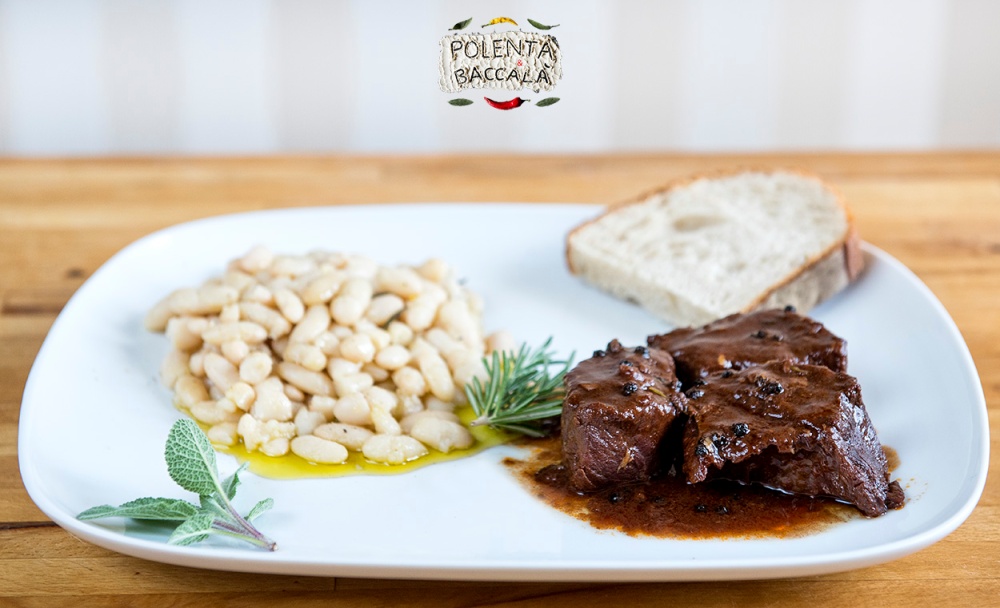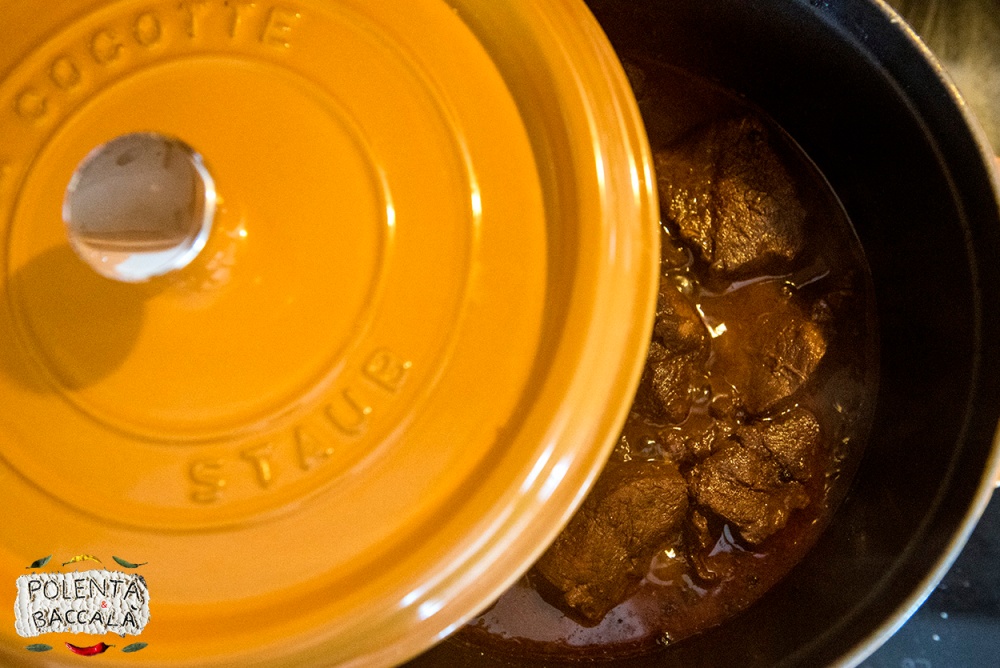
This is a very tasty and juicy recipe, typical of Tuscany and more precisely of Florence area.
It’s a very old recipe, and its complete name is “Peposo alla fornacina” or “Peposo dell’Impruneta“, because it seems it was created in the XV century by some brick cookers at the kilns situated at Impruneta, a town on the hills surrounding Florence and well known for terracotta productions. The story says that in that period, at the time of Brunelleschi, during the construction of the very famous cupola of Florence Cathedral, there was a higher request of bricks and as a consequences there were more “fornacini” (the workers) working at the kilns. These workers were working hard from morning until evening and didn’t have much money, so some of them started to put what they could manage to find inside some terracotta pots and place it to cook slowly just at the entrance of the kilns (not to burn it), for long hours until lunch time. The favorite meat were the poor cuts of the beef (or cow/ox), usually from the legs/thighs, and by cooking so slowly and for so many hours those cuts could become very tender. Then it was enough to add just a lot of pepper, garlic (in Middle Age time it was used a lot) and wine, and the first “Peposo” was born 🙂 (Peposo derives from the word “pepe“, which in Italian means pepper).
It seems also that Brunelleschi had a problem: when many of his workers were going to have lunch in the taverns they were coming back often too late and drunken, creating a big loss of time for the works. So, after he tried this dish and learnt the story behind, he decided to create two “canteens” directly on the working place, were the “Peposo” was often prepared. In this way he solved its problem with those workers. It seems that this dish helped also to the construction of the Florence Cathedral, maybe 😀
Of course, we don’t know how much is legend and how much is reality 🙂 but for sure there is something true (moreover, at that time there were no fridges and often spices as the pepper and also the garlic were used in high amounts also to cover bad tastes/smells of meat that was no more so fresh).
As you can logically imagine, in the XV century the America was yet to be discovered, so for sure there was no tomato in the first recipes. But nowadays many people use to add some triple tomato concentrate or some tomato sauce. That’s up to your choice.
Wine: the tradition, also to keep a connection with the territory, wants Chianti wine to be used. But you can use also other red wines, obviously. The quantity depends on how much meat you use and how big is the pot/cocotte you use: this time I used 950 grams of meat and the cocotte had a perfect size to exactly contain that meat, so I used just about 450 ml of wine and a cup of hot water in which I diluted the triple tomato concentrate. That was enough to cover the meat. But for more meat or for larger pots you should count more wine, in any case it has to be enough to exactly cover the meat.
Moreover, to cook this recipe according to the tradition you should use a terracotta pot, and cook it in a wood oven, but also a good pot in cast iron or other materials good for long time cooking are perfect, and also to prepare it on a low flame rather than in the oven.
I chose to pair this recipe with white beans that with their sweetness dampen the intense flavor of the meat (for 4 people I used 300 grams of dry beans, that soaked in water for a whole night double their weight), simply boiled in water with some rosemary, sage and two cloves of garlic, and seasoned then with extra virgin olive oil and freshly ground black pepper (it’s a very common side dish in Tuscany, especially the “cannellini” type), but also mashed potatoes, polenta or just a good bread are perfect pairings for this dish.
Let’s see the recipe now.
INGREDIENTS (4 people):
- 1 kg of beef meat (cuts as the blade, cheek, shank, flat iron, chuck, etc.: cuts with connective tissue)
- about 500 ml of red wine (read above)
- two tablespoons of black peppercorns
- 7-8 cloves of garlic
- 2-3 fresh bay leaves
- 1 sprig of rosemary
- 5-6 fresh sage leaves
- 1 tablespoon of triple tomato concentrate (optional)
- extra virgin olive oil (optional)
- salt
- First of all cut the meat into big pieces of the same size, about 6-8 cm large. Then peel the cloves of garlic and prepare the peppercorns.
- Take your cocotte/pot and place inside the meat (I also put a couple of tablespoons of extra virgin olive oil, but this is optional and not part of the traditional recipes), the cloves of garlic (the whole, don’t squeeze/crush them), the peppercorns, the herbs and add the wine. Mix together and let it marinate for at least 30 minutes, better one hour.

- After this time add the triple tomato concentrate diluted in some warm water, season with some salt (just some, you’ll check better at the end when the sauce has reduced) and place the cocotte over the fire at medium heat until it reaches the boil, then from that moment set the heat at the minimum and let it simmer very slow for at least 3 hours long (but the exact time depends on which cut you used, in how big pieces you cut the meat, which animal, etc.). Keep the cocotte/pot covered, leave just a little small space open, and turn the pieces of meat sometimes: I turned them about every hour, so 3-4 times. Before serving the meat remove the herbs and the cloves of garlic. Should you see that the liquid gets shorter while cooking you can add some hot water (in my case it was not necessary).

- When you see that the meat is very tender and break easily then it’s ready. Control if the salt is enough and if the sauce is not thick enough you can set the heat higher and reduce it for few minutes. I also added some freshly ground black pepper at the end, but this is up to your taste.
- Serve it and enjoy with a good glass of wine! 🙂 it was simply delicious, and I didn’t need the knife to cut it: it was so tender 🙂
PS: as always with this kind of recipes, if something remains then you can use it to make a great sauce for a pasta on the day after 😉


————————————————————————————
Products used in this recipe:
Meat: free range Angus beef from “Terra Pannonia” farms
Appetitosissimo!!! Complimenti
LikeLiked by 1 person
Grazie! 🙂
LikeLike
Wow! It’s so tempting.
LikeLiked by 1 person
Thank you 🙂
LikeLiked by 1 person
Delicious.
LikeLiked by 1 person
Thank you!
LikeLike
looks stunning 🙂
LikeLiked by 1 person
Thank you Anita 🙂
LikeLike
Look amazing ! And can I tell you one more time, how I enjoy your history and background stories 🙂
LikeLiked by 1 person
Thank you Ruta 🙂 that makes me glad every time 🙂 as I already told you, I really like the story behind traditional recipes, and I like to share those stories more than the recipe itself, maybe.
I know that many readers skip the too long introductions and go directly to the recipe/ingredients part, but I know that there are also many people like you and me that like to read everything and to know something more than just the ingredients 🙂 that’s why (when I can) I always write something more 🙂
LikeLike
🙂
LikeLiked by 1 person